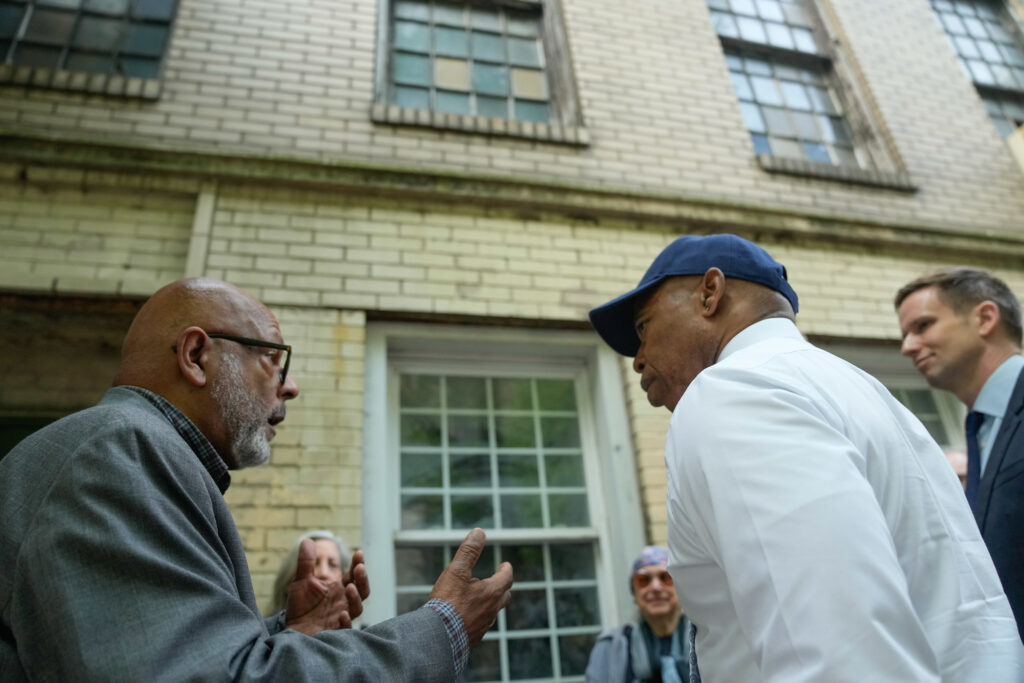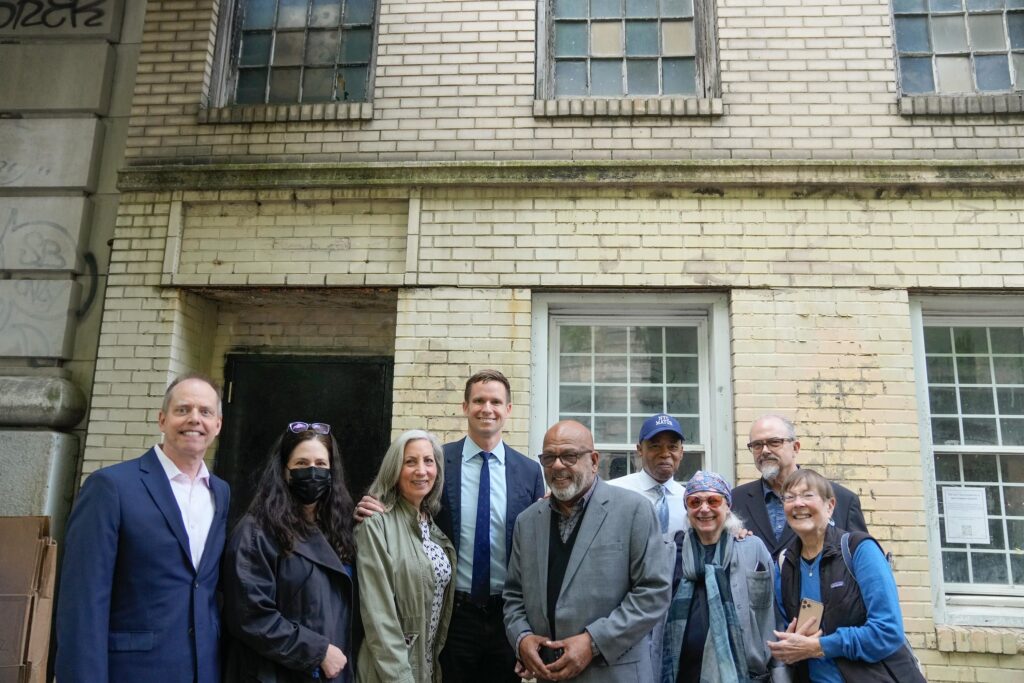Millions of people have walked past the rather nondescript three-story building on West 17th Street in New York City’s Chelsea neighborhood without paying it any mind. But ever since Eric K. Washington stumbled upon it in 2018, it has been his passion and, short of shouting from rooftops, he has made sure that anyone in his orbit knows why.
After all, when it comes to the Black American footprint in the United States, how many 175-year-old buildings can we point to that reflect racial pride, perseverance, struggle, a flowering of the arts – and a Civil War battle of sorts to boot?

Once known as Colored School No. 4, the institution served hundreds of Black children from 1860-1890 while led by educators with ties to the abolitionist, suffragist, religious and cultural movements.
Nothing was more dramatic, however, than when the Civil War literally arrived at the school’s front door during the Draft Riots, that point around the time of the Battle at Gettysburg when Irishmen went wilding in the streets, angry that they were being drafted to fight in a war that they said had nothing to do with them. They took out their anger on Black men, women and children, even burning down an orphanage to make their point.
“The mob congregated in front of the Sixteenth Ward School-House, in Seventeenth street, while the school was in session, and made a demonstration with a view to gain entrance to the building,” the New York Daily Tribune reported. “It seems that two colored women whom they had pursued had taken refuge in the school-building, and they were determined to get at them. The teachers promptly barred all the doors leading into the street, and the rioters, after a few ineffectual efforts to break in, turned their attention to … the opposite side of the street … .”
The leader of the school was Sara Tompkins, who had only been principal for a short time. Not only was she a pioneering educator, but she was also a cofounder of the Equal Suffrage League of Brooklyn and a member of the National Association of Colored Women’s Clubs. She later married the noted abolitionist and orator Henry Highland Garnet, for whom a “colored school” in Baltimore was later named.
All these captivating tales came to light because Washington had been curious to know what might be left of the Chelsea neighborhood that once had a significant Black presence. It had been the boyhood home of James Williams, a man of influence in the Black New York of his day and the subject of Washington’s book, “Boss of the Grips: The Life of James H. Williams and the Red Caps of Grand Central Terminal.” (Liveright, 2019)
In May, the New York City Landmarks Commission rewarded Washington’s efforts to protect 128 West 17th Street from the greed of developers, the whims of politicians, and the fickleness of human memory by declaring the building a landmark. It now joins an impressive list of sites formally recognized by New York City for their connection to Black life over the centuries.

While there are now national research centers and museums dedicated to Black history – the newest being the International African American Museum that’s set to open in Charleston, South Carolina, at the end of June – it is really on the local level that a broad spectrum of preservation and proclamation is evident.
“It seems like more is happening,” said Peggy King Jorde, an international cultural consultant on historic sites with significant connections to Black heritage. “I have my Google alert on, and I get articles every single day and sometimes several times a day about communities all over the country working to preserve certain sites.”
King Jorde cut her teeth in preservation and politics during the administration of the late David N. Dinkins, New York City’s first Black Mayor. Dinkins named Jorde executive director of a steering committee tasked with negotiating the future of a Black burial ground unearthed in 1991 during construction of a federal office building. With eyes planted on a goal, King Jorde and her team worked from inside City Hall; politicians like the late U.S. Rep. Gus Savage (D-Illinois) held the government accountable through public hearings and negotiations; and thousands of people took to the streets for marches and vigils. The result? The African Burial Ground National Monument was listed on the National Register of Historic Places in 1993 and declared a national historical landmark in 2006. Its sacred status is maintained by the people.
Washington, a freelance journalist whose affinity for little-known stories of Black New York led to self-actualization as a public historian, was one of those people for whom the burial ground odyssey was an eyeopener.
“As a result of that discovery and the aftermath of vigils and protests and scrutiny, a lot of people were really inspired to begin digging in their attics and their backyards,” Washington explained.
The epiphany, he said, was a realization that “somebody was there before you and chances are that they left something that’s there for your discovery.”
When he “discovered” the city-owned building on West 17th Street was not being used for anything, “that scared me,” he recalled. “As a New Yorker, I knew that anything that sits idle doesn’t stay idle for very long. If nothing else, you’ll have critters — rats and vermin — occupying the place, but also if it was not being used, that could mean that they were ready to sign contracts with wrecking crews.”
So Washington immediately submitted a request to the New York City Landmarks Preservation Commission to save the building.
Years of making presentations and securing the support of community organizations, politicians, preservationists, academics, editorial boards and regular folks led to a unanimous vote on May 23 to grant the building landmark status. Mayor Eric Adams quickly announced that he’d make $6 million available for rehabilitation of the building.
Around the nation, similar campaigns are in bloom.
In Aiken, South Carolina, an 1890 building founded as a school for Blacks is now thriving as the Center for African American History, Arts and Culture – listed by the National Registry of Historic Places under the authority of the National Parks Service.
In Baltimore, the old school building named after Henry Highland Garnet – husband of Colored School No. 4’s principal – is undergoing a multimillion dollar transformation to become The Thurgood Marshall Center. Located in the heart of what is known as Old West Baltimore, it is where Marshall attended elementary school decades before he became the first Black associate justice of the United States Supreme Court.
Throughout the South, old schools built through the philanthropy of Julius Rosenwald, a founder of what became Sears, are being brought to life. And numerous burial grounds – including sites in New York City, Maryland, Georgia, Texas, Virginia, and Ohio – are in various stages of reclamation.
The will to enshrine the Black presence is meeting countermeasures to erase it, as in Florida, where the teaching of Black, feminist and queer history is being criminalized. That makes these historic spaces perhaps as critical now as they were originally because, like the Emancipation Oak in Hampton, Virginia, “that’s where we can teach students about the whole of history without leaving blank spots,” said Jennifer Tolson Curtis, the chair of the center in Aiken.
The energized campaigns are welcomed by people like King Jorde, but she cautions that securing a site as a landmark is not enough to actually save it.
“That only happens if we go there and we make something happen there,” she said. In other words, there must be programming that draws people on a regular basis, “so it becomes a living site of memory in our community or a site of conscience in our community.”
In New York City, plans are underway to take former Colored School No. 4 to what King Jorde refers to as “the next level” with ideas afloat to transform it into a cultural center that echoes its original use as a school, engaging young people and adults through educational programs, exhibitions and live performances.








